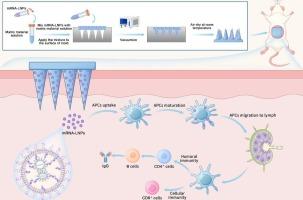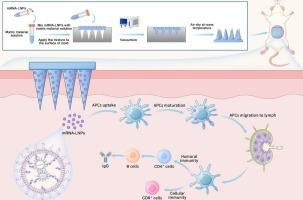Development of a dissolving microneedle patch for transdermal delivery of SARS-CoV-2 mRNA vaccine with enhanced stability and immunogenicity
IF 11.5
1区 医学
Q1 CHEMISTRY, MULTIDISCIPLINARY
引用次数: 0
Abstract
Microneedles (MNs)-based transdermal delivery systems present a promising alternative to intramuscular injection (IM) for mRNA vaccines, offering improved patient compliance, enhanced skin-targeted delivery, and increased vaccine stability while reducing hepatic accumulation of lipid nanoparticles (LNPs). Here, we developed a dissolving microneedle patch (DMP) for SARS-CoV-2 mRNA vaccine RQ3013 delivery, employing a matrix composed of 15 % polyvinyl alcohol (PVA) and 10 % polyvinylpyrrolidone (PVP) for its optimal mechanical properties and mRNA-LNPs compatibility. We utilized the one-step vacuum micro-molding process to fabricate DMP loaded with mRNA-LNPs, which significantly improved the encapsulation efficiency of mRNA-LNPs in MNs from 72.34 ± 1.44 % (two-step vacuum micro-molding process) to 95.54 ± 1.29 %. In vivo imaging revealed that the one-step DMP achieved 2.2-fold higher cumulative fluorescence intensity than the two-step DMP and 2.6-fold higher than IM. The DMP preserved the key physicochemical properties and biological functions of mRNA-LNPs, enabling efficient cellular uptake and target antigen expression following successful endosomal escape. Remarkably, the DMP exhibited excellent stability, with no significant changes in key properties after 30 days of storage at room temperature. Notably, the DMP induced a comparable IgG response to IM (5 μg) at a substantially lower actual delivery dose (approximately 2 μg), without systemic toxicity or skin irritation. These findings demonstrate that this DMP represents an effective, stable, and patient-friendly strategy for mRNA vaccine delivery, combining enhanced immunogenicity with improved storage stability and simplified administration.


用于经皮递送SARS-CoV-2 mRNA疫苗的溶解性微针贴剂的研制,具有增强的稳定性和免疫原性
基于微针(MN)的透皮给药系统为mRNA疫苗的肌肉注射(IM)提供了一种有希望的替代方案,可改善患者依从性,增强皮肤靶向递送,提高疫苗稳定性,同时减少脂质纳米颗粒(LNPs)在肝脏的积累。在这里,我们开发了一种用于SARS-CoV-2 mRNA疫苗RQ3013传递的溶解性微针贴片(DMP),采用由15 %聚乙烯醇(PVA)和10 %聚乙烯吡咯烷酮(PVP)组成的基质,以获得最佳的机械性能和mRNA- lnps兼容性。我们利用一步真空微成型工艺制备了装载mRNA-LNPs的DMP,将mRNA-LNPs在MNs中的包封效率从72.34 ± 1.44 %(两步真空微成型工艺)显著提高到95.54 ± 1.29 %。体内成像显示,一步DMP的累积荧光强度比两步DMP高2.2倍,比IM高2.6倍。DMP保留了mRNA-LNPs的关键物理化学性质和生物学功能,使其能够在成功的内体逃逸后有效的细胞摄取和靶抗原表达。值得注意的是,DMP表现出优异的稳定性,在室温下储存30 天后,关键性能没有明显变化。值得注意的是,DMP在较低的实际给药剂量(约2 μg)下诱导了与IM(5 μg)相当的IgG反应,没有全身毒性或皮肤刺激。这些发现表明,这种DMP是一种有效、稳定和对患者友好的mRNA疫苗递送策略,结合了增强的免疫原性、改善的储存稳定性和简化的给药。
本文章由计算机程序翻译,如有差异,请以英文原文为准。
求助全文
约1分钟内获得全文
求助全文
来源期刊

Journal of Controlled Release
医学-化学综合
CiteScore
18.50
自引率
5.60%
发文量
700
审稿时长
39 days
期刊介绍:
The Journal of Controlled Release (JCR) proudly serves as the Official Journal of the Controlled Release Society and the Japan Society of Drug Delivery System.
Dedicated to the broad field of delivery science and technology, JCR publishes high-quality research articles covering drug delivery systems and all facets of formulations. This includes the physicochemical and biological properties of drugs, design and characterization of dosage forms, release mechanisms, in vivo testing, and formulation research and development across pharmaceutical, diagnostic, agricultural, environmental, cosmetic, and food industries.
Priority is given to manuscripts that contribute to the fundamental understanding of principles or demonstrate the advantages of novel technologies in terms of safety and efficacy over current clinical standards. JCR strives to be a leading platform for advancements in delivery science and technology.
 求助内容:
求助内容: 应助结果提醒方式:
应助结果提醒方式:


